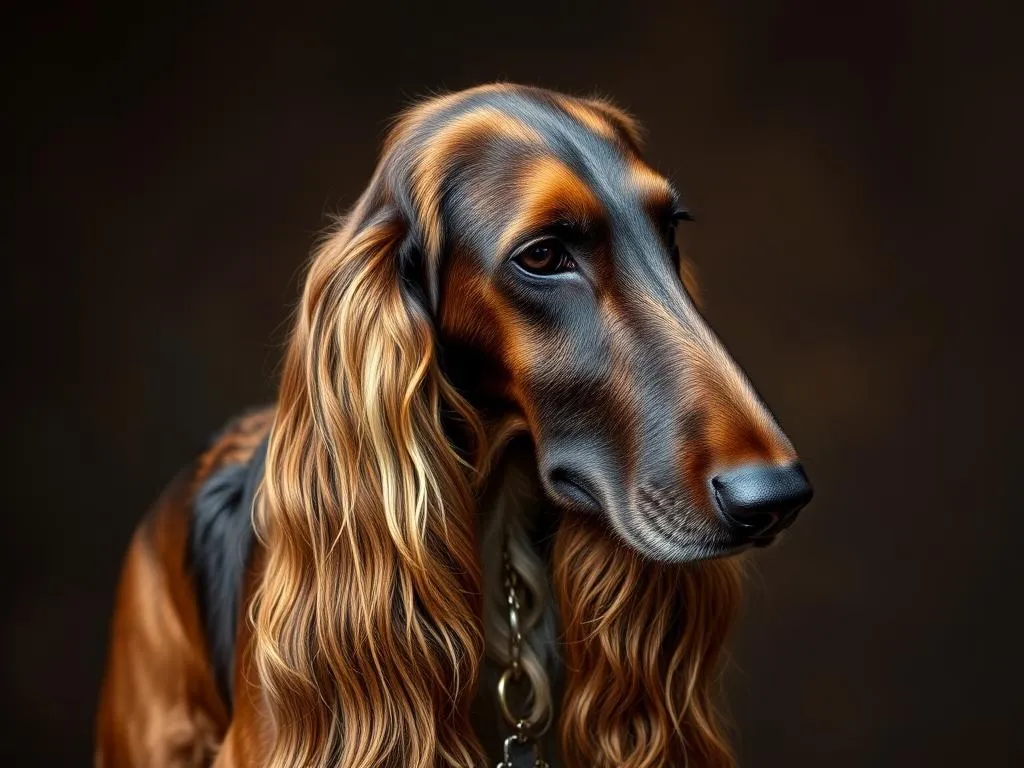
Introduction
The world of dog breeds is incredibly diverse, with each breed boasting its own unique traits and characteristics. Among these, the Afghan Hound stands out for its elegance and distinctive appearance, making it a fascinating breed to explore. Understanding the unique features of the Afghan Hound is crucial for anyone considering bringing one into their home. Choosing the right breed can significantly affect an owner’s lifestyle and overall happiness, as different breeds come with varying needs and temperaments.
Understanding Dog Breeds
Definition of Dog Breeds
A dog breed is a specific group of dogs with particular characteristics, appearances, and behaviors that distinguish them from other breeds. Breeds are typically established through selective breeding, where dogs with desired traits are paired to produce offspring that inherit those traits. This can lead to purebred dogs, which are bred from a recognized lineage, or mixed breed dogs, which result from the combination of two or more breeds.
Importance of Breed Characteristics
Understanding breed characteristics is vital for potential dog owners. Each breed has unique behavioral traits, health considerations, and care requirements. For instance, the Afghan Hound, known for its independent nature and high grooming needs, requires an owner who can accommodate its specific lifestyle demands. Additionally, breed characteristics play a significant role in training and socialization, as each dog responds differently to training techniques based on their inherent traits.
Afghan Hound Overview
History of the Afghan Hound
The Afghan Hound is one of the oldest dog breeds, with a rich history that dates back thousands of years in Afghanistan. Originally bred for hunting large game in the rugged terrains of the Afghan mountains, these dogs were highly valued for their speed, endurance, and keen eyesight. The breed’s cultural significance extends beyond its utility; it has been a symbol of nobility and grace in Afghan culture. The Afghan Hound’s elegant appearance and dignified demeanor have captured the hearts of dog lovers around the world.
Physical Characteristics
The Afghan Hound is known for its striking appearance. Adult Afghan Hounds typically weigh between 50 to 60 pounds and stand about 24 to 29 inches tall at the shoulder. Their long, flowing coat can be found in various colors, including cream, black, and fawn, often with distinctive markings. One of their most notable features is their long, narrow head and unique topknot of hair. Grooming is essential for this breed, as their silky coat requires regular brushing to prevent matting and to maintain its luxurious appearance.
Temperament and Behavior
Afghan Hounds are known for their independent spirit and strong-willed nature. While they are affectionate and loyal to their families, they can also be aloof with strangers. This breed is generally good with children but may not tolerate rough play. Afghan Hounds are intelligent but can be somewhat stubborn, making training a challenge. Patience and consistency are essential when working with this breed, as they may require extra time to grasp commands and expectations.
Care and Maintenance of Afghan Hounds
Grooming Needs
The grooming needs of the Afghan Hound are quite extensive due to their long, fine coat. Regular brushing is essential, at least two to three times a week, to prevent tangles and mats. Bathing should be done monthly or as needed, using a gentle shampoo designed for long-haired breeds. Additionally, professional grooming every few months can help maintain their coat’s health and appearance. Keeping the ears clean and nails trimmed is also crucial for overall hygiene.
Diet and Nutrition
A balanced diet is vital for the health of Afghan Hounds. High-quality dog food that lists meat as the first ingredient is recommended. It’s essential to feed them according to their age, weight, and activity level. Puppies have different nutritional needs than adults, and senior dogs may require specialized diets to address age-related health issues. Always consult with a veterinarian to determine the best dietary plan for your Afghan Hound.
Exercise and Activity Level
Afghan Hounds are active dogs that require regular exercise to stay healthy and happy. Daily walks, playtime in the yard, or visits to a dog park are essential for their physical and mental well-being. Because of their hunting background, they enjoy running and can benefit from off-leash time in a secure area. Mental stimulation is equally important; engaging them in activities like puzzle toys or agility training can help keep their minds sharp.
Training an Afghan Hound
Training Basics
Training an Afghan Hound can be a rewarding yet challenging experience. These dogs are intelligent but often have a strong independent streak. Basic commands like sit, stay, and come should be taught using positive reinforcement techniques, such as treats and praise. Consistency is key, as Afghan Hounds may test boundaries if they sense a lack of firmness from their trainers.
Socialization Techniques
Early socialization is crucial for Afghan Hounds to develop into well-rounded adults. Exposing them to various environments, people, and other animals from a young age helps reduce the likelihood of fear-based behaviors. Puppy classes or playdates with other friendly dogs can assist in this process. The goal is to create positive experiences that will shape their understanding of the world around them.
Addressing Common Behavioral Issues
Like any breed, Afghan Hounds can exhibit behavioral challenges. Common issues include stubbornness, sensitivity to harsh training methods, and potential separation anxiety. Positive reinforcement techniques are the most effective way to address these challenges. For instance, rewarding good behavior with treats or praise can encourage them to repeat those actions. Consistency and patience are essential in managing any behavioral issues that arise.
Health Considerations
Common Health Issues
While Afghan Hounds are generally healthy dogs, they are prone to certain health issues. Hip dysplasia, a genetic condition affecting the hip joint, is relatively common in this breed. Other potential concerns include allergies, certain cancers, and thyroid issues. Regular veterinary check-ups can help monitor these conditions, and early detection is crucial for effective treatment.
Regular Vet Care
Routine veterinary care is essential for maintaining the health of Afghan Hounds. Regular vaccinations, flea and tick preventatives, and annual check-ups should be part of their healthcare routine. Discussing diet and exercise with a veterinarian can also help ensure that your Afghan Hound remains healthy throughout its life.
Lifespan and Aging
The average lifespan of an Afghan Hound ranges from 12 to 14 years. As they age, their needs may change, requiring adjustments in diet, exercise, and healthcare. Senior Afghan Hounds may benefit from joint supplements to support mobility and comfort. Keeping an eye on their health and adjusting their care as needed will help enhance their quality of life in their golden years.
Afghan Hound in Popular Culture
Representation in Media
The Afghan Hound has made notable appearances in various movies and television shows, often portrayed as a symbol of elegance and grace. Their unique looks have captured the attention of filmmakers and pet lovers alike. Films like “The Adventures of Milo and Otis” and shows like “The Dog Whisperer” have showcased these beautiful dogs, contributing to their status in popular culture.
Famous Afghan Hounds
Throughout history, several Afghan Hounds have gained fame, further enhancing the breed’s popularity. Notable Afghan Hounds like “Tug,” who appeared in the 1979 film “The Incredible Journey,” and “Jasmine,” who gained fame through dog shows, have helped to showcase the breed’s unique characteristics. Their influence has left a lasting impact on how the breed is perceived and appreciated.
Conclusion
The Afghan Hound is a breed that embodies elegance, independence, and a rich historical background. Their unique grooming needs, exercise requirements, and temperament make them a special breed that requires a committed and knowledgeable owner. Understanding the intricacies of the Afghan Hound can help prospective owners make informed decisions and ensure a harmonious relationship with their new canine companion.
FAQs
What is the average price of an Afghan Hound?
The average price of an Afghan Hound can range from $1,000 to $3,000, depending on the breeder’s reputation, location, and the dog’s lineage.
How much exercise does an Afghan Hound need?
Afghan Hounds require a significant amount of exercise, typically around 60 minutes of physical activity each day, including walks, playtime, and off-leash running in a safe environment.
Are Afghan Hounds good family pets?
Yes, Afghan Hounds can be good family pets, particularly in families with older children. They are affectionate yet independent dogs that thrive in a loving environment.
What is the best environment for an Afghan Hound?
Afghan Hounds thrive in spacious environments where they have room to run and play. A home with a secure yard is ideal, but they can also adapt to apartment living if given ample opportunities for exercise and mental stimulation.









